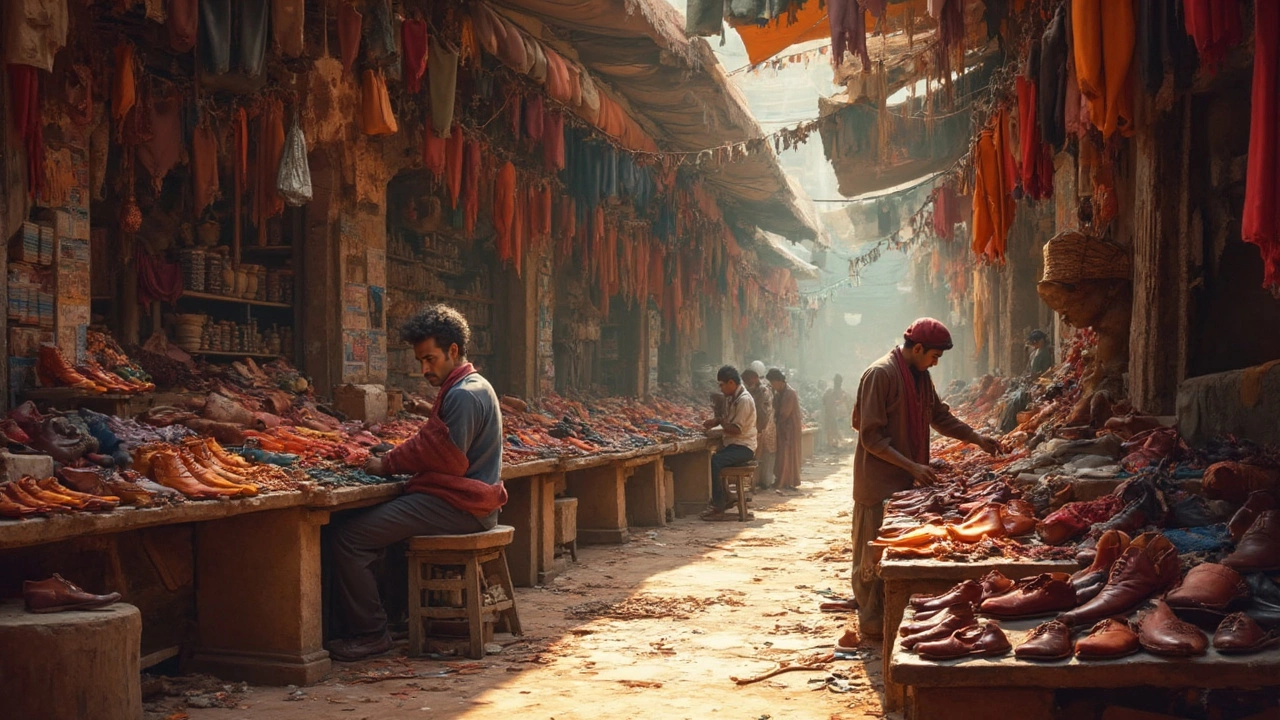High-Quality Leather for Shoes: What to Look For

Ever tried getting that perfect pair of leather shoes and ended up confused by all the options? You're not alone. Picking high-quality leather can feel like a maze if you're not familiar with what to look for. But don't worry; I'm here to help guide you!
First things first—let’s talk about why quality matters. Good leather doesn’t just look and feel better; it also lasts longer. Who wouldn’t want to invest in a pair of shoes that stand the test of time and still look fab season after season?
So, how do you spot this elusive high-quality leather? It all begins with understanding the types. Full-grain leather, for instance, is often hailed as the pinnacle of leather because it uses the entire grain of the hide, making it tough yet breathable. Then there's top-grain leather, which is a bit more refined with a thinner appearance and often more affordable. Each serves its purpose, depending on what you're aiming for—durability or a sleek look.
- Introduction to Leather Quality
- Types of High-Quality Leather
- Identifying Premium Leather
- Care Tips for Leather Shoes
- Common Misconceptions
Introduction to Leather Quality
So, what exactly makes leather high-quality? It's not just about looking shiny and luxurious. High-quality leather is all about the durability, comfort, and the way it ages over time. Trust me, it's more science than magic!
First up, the way leather is sourced and processed plays a huge role. For example, full-grain leather is considered top-notch because it's made from the strongest and most durable part of the animal hide. That's why full-grain leather can withstand wear and tear while developing a beautiful patina as it ages. This is why many people consider it the gold standard, especially for leather shoes.
To break it down a bit, here's a nifty rule of thumb: the fewer the alterations, the higher the quality. So, leathers that have been buffed, sanded, or altered significantly? Yeah, those usually aren't as good in quality compared to full or top-grain leathers. They might look nice upfront, but they won’t age as gracefully.
Grading Leather Quality
Experts often grade leather on a scale considering factors like texture, appearance, and uniformity of the material. Generally, leather falls into categories like full-grain, top-grain, corrected-grain, and split leather. Full-grain often tops the list due to its natural toughness and breathability. It’s kind of like the leather world’s Ferrari.
- Full-Grain Leather: The whole hide, with all its natural marks. Sturdy and best for leather shoes that last.
- Top-Grain Leather: Slightly altered, smoother, but not as sturdy as full-grain.
- Corrected-Grain Leather: This is sanded down to remove imperfections, giving it a uniform finish.
- Split Leather: Least durable; often used for cheaper goods and lower quality shoes.
Knowing these differences can really boost your confidence when choosing leather shoes. Remember, high-quality leather with minimal alterations is what you want to aim for!
Fun Fact
Did you know the leather industry uses over a billion square feet of hides and skins annually? Imagine a whole city paved with leather shoes—that’s a lot of leather! As it stands, the shoe industry is one of the biggest consumers of leather worldwide.
Types of High-Quality Leather
Choosing the right type of leather for your leather shoes can make all the difference in terms of comfort, durability, and appearance. Let’s break down the most common high-quality options you'll encounter when shopping.
Full-Grain Leather
Full-grain leather is often considered the gold standard. It uses the entire grain of the hide, meaning it hasn't been sanded or buffed to remove imperfections. This makes it incredibly tough and resistant to moisture, while still allowing the leather to breathe. It's perfect for high-quality footwear because it develops a desirable patina over time, meaning your shoes can actually look better as they age.
Top-Grain Leather
Next up is top-grain leather, which is a step down from full-grain but still a fantastic choice. It’s sanded and a finish coat is applied, which means it’s more pliable while sacrificing some breathability. Typically, top-grain leather is used for its sleek, uniform appearance, making it perfect for folks who prefer a polished, clean look.
Patent Leather
Looking for something glossy? Patent leather is here to bring that shine. It’s a type of top-grain leather coated with a high-gloss finish, known for its sleek, shiny surface. This type doesn’t breathe as well but makes a bold fashion statement with minimal care needed.
Nubuck
Similar to suede, but made from the outer side of the hide, nubuck leather is known for its soft texture. It's sanded down for a velvety feel and offers a unique, matte finish. However, it tends to be more delicate and susceptible to stains or water damage.Bonded Leather
Okay, so bonded leather isn't exactly high-quality, but it often gets mistaken as such. It's made from leather scraps bonded together and coated, making it the least expensive option. It’s not as durable or long-lasting, so give it a pass if you’re looking for quality.
When you're choosing high-quality leather for shoes, think about what you'll use them for and how much maintenance you're willing to do. The goal isn’t just to find the most luxurious option, but rather the one that fits your lifestyle best.

Identifying Premium Leather
Getting a grasp on what makes leather high-quality is crucial when shopping for leather shoes. You don't want to be investing your hard-earned money on what you think is a premium pair only to find out they've scuffed and worn out faster than expected.
First off, one of the easiest ways to identify premium leather is by the feel and smell. High-quality leather usually feels smooth yet firm. It doesn’t have that plasticky or artificial feel. And then there's the smell—good leather has a rich, earthy aroma that's hard to fake. Trust your senses!
Look Out for Natural Marks
A hallmark of full-grain leather is its natural imperfections. Yep, you heard me right. Scars, wrinkles, and blemishes tell the story of the hide. They mean that the leather hasn’t been sanded down to cover up flaws, retaining its strength and breathability.
Check the Stitching
Quality leather shoes often have robust and neat stitching. Pay attention to the seams. They should be even and tight, which means they're carefully crafted and intended to last. Cheap stitching tends to unravel fast, which is a dead giveaway.
Test the Material
- Water Drop Test: Drop a little water on the leather. High-quality leather will absorb the water slowly, while fake leather will leave the drop sitting on top.
- Bend Test: Gently bend the shoe. Real leather bends smoothly and won't show any cracks. Artificial leather might give in too easily and show creases.
Last but definitely not least, check the label and the place you're buying from. Trustworthy brands usually boast about using top-grain or full-grain leather because it adds value to their product.
Care Tips for Leather Shoes
You’ve got your hands on those high-quality leather shoes, now what? Proper care is essential to keep them looking sharp and lasting longer. Let's break down some easy-to-follow tips so your shoes can keep stepping in style.
Regular Cleaning
First off, keep your leather shoes clean. Dust and dirt can make them look worn out. Use a soft brush or cloth to wipe off any surface dirt. Avoid water, as leather can soak it up and leave stains. If your shoes get wet, let them air dry naturally.
Conditioning the Leather
Leather is like skin—it needs moisturizing! Leather conditioner keeps the material supple and prevents cracks. Apply a small amount with a cloth every few months. Be sure to test on a small area first to check how it reacts.
Avoiding Excessive Heat and Moisture
High-quality leather doesn’t gel well with heat or moisture. Don’t leave your shoes in a hot car, and avoid wearing them in rain as much as possible. If they do get wet, stuff them with newspaper and let them dry in a cool, dry place.
Polishing for Shine
Want that sleek, polished look? Use a good quality shoe polish that matches the color of your shoes. A bit of polish and a buff can make your shoes shine like new. Make sure to buff them with a soft cloth afterward.
Storage and Maintenance
When not wearing your beloved leather shoes, store them properly. Use shoe trees to help maintain their shape. Keep them in a well-ventilated, dry area to prevent mold or odors.
These tips are simple, yet they make a world of difference in maintaining leather shoes in top condition. High-quality leather deserves high-quality care, and now you're equipped with the know-how to make that happen!

Common Misconceptions
When it comes to leather shoes, there's a lot of misinformation that can lead you astray. Let's bust some of those myths right here and now.
1. Real Leather is Always High Quality
Just because something is labeled as real leather doesn't necessarily mean it's high quality. 'Genuine leather' tags often refer to lower-quality leather that's heavily treated and won't last as long as premium options like full-grain leather.
2. Expensive Equals Better
A higher price tag doesn't automatically mean better leather. Many times, you're paying for brand or design rather than the leather quality itself. Knowing what makes leather high-quality—like its grain and treatment—can help you spend wisely.
3. Leather Can't Be Waterproof
Most people think leather and water don’t mix, but that’s not entirely true. Types of treated leather can withstand exposure to moisture. Just make sure the shoes have been appropriately prepared or have a waterproof finish applied.
4. Darker Leather is Stronger
Some people believe darker leather is stronger, but color has nothing to do with strength. The quality largely depends on the leather type and the manufacturer's processing method.
5. High-Quality Leather Needs Constant Conditioning
While regular care is essential, over-conditioning can do more harm than good. Too much treatment can make leather soft and reduce its lifespan. Stick to the manufacturer’s guidelines for the best results.
Understanding these misconceptions can guide your next leather shoes purchase, ensuring you focus on what truly matters—the quality of the leather itself.